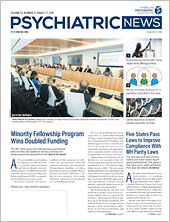Gender dysphoria” may someday go the way of homosexuality as a diagnosis in the DSM.
So said psychiatrists and other clinicians at a forum titled “Demystifying Gender Dysphoria,” held last month in the Rayburn House Office Building on Capitol Hill. The forum was sponsored by APA and the American Psychological Association.
Eric Yarbrough, M.D., vice chair of APA’s Council on Minority Mental Health and Health Disparities and a member of APA’S LGBTQ Caucus, recounted the evolution of diagnoses related to gender identity within DSM: it began as a category of “sexual deviations” and later “psychosexual disorders.” Today’s diagnosis of “gender dysphoria” describes a condition of “marked incongruence between one’s experienced/expressed gender and assigned gender” along with “clinically significant distress or impairment in social, occupational, or other important areas of functioning.”
Yarbrough said this evolution roughly mirrors the history of homosexuality in DSM. Homosexuality was listed as a disorder in DSM-I and DSM-II and dropped from DSM-II in 1973. In DSM-III, the diagnosis of “ego-dystonic homosexuality” was included to denote individuals who were distressed about their sexual orientation. This diagnosis was dropped with the publication of DSM-III-R. (Yarbrough noted that the diagnosis was sometimes used to justify reparative therapy.)
Similarly, gender dysphoria may some day be taken out of DSM as well. “Many gender-affirming psychiatrists would like to see it removed entirely from DSM,” Yarbrough said.
Michael Hendricks, Ph.D., a psychologist with the Washington Psychological Center, outlined the “minority stress model,” which seeks to explain how individuals in any minority category—including transgender and gender noncomforming (TGNC) people—encounter social and environmental stress that can result in mental illness.
“TGNC people, like all people, encounter general life stressors that can result in a wide range of reasons for needing psychological care,” he said. “However, beyond these general stressors, TGNC people are subjected to excessive rates of discrimination, violence, and rejection related to their gender identity or expression. It is to these experiences that we attribute a potentially greater need for mental health services.”
Hendricks said “minority stress” is understood to be additive to general stressors experienced by all people, chronic, and related to relatively stable underlying social and cultural structures. “There are a number of pathways to increased pathology, including substance use/dependence, mood disorders, and suicidal behaviors,” he said.
But Hendricks added that experiencing prejudice and routine insults can also lead to coping and resilience. “Coalescing around minority identity produces group solidarity and cohesion that serve as protective factors. The minority stress model proposes that exposure to and engagement with others of one’s own minority status lead to development of a minority identity, which ultimately lead to increased self-esteem and psychological health. It also contributes to a sense of belonging, which satisfies a basic psychological need.”
He added, “Thwarted belongingness has been strongly implicated in negative mental health outcomes and suicide.”
Hendricks cited a number of professional standards, competencies, and guidelines that can guide clinical care for TGNC people. These include Standards of Care of the World Professional Association for Transgender Health, Guidelines for Psychological Practice With Transgender and Gender Nonconforming People of the American Psychological Association, and Endocrine Treatment for Gender Dysphoric/Gender Incongruent Persons of the Endocrine Society.
APA’s “Guide for Working With Transgender and Gender Nonconforming Persons” can be accessed by APA members
here.
For TGNC individuals seeking medical care, Hendricks said that “the key is in finding providers who are both knowledgeable about gender diversity and gender-affirmative approaches and who have developed the skills to deliver these approaches.” ■

